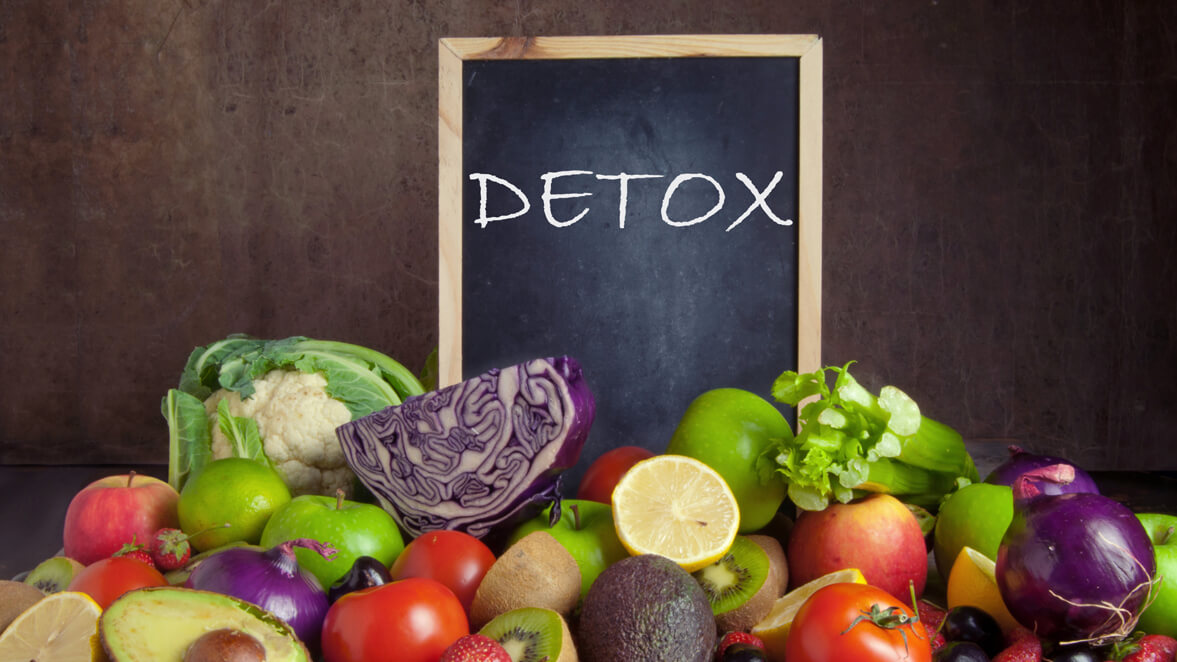
6 Signs Of Toxins Leaving The Body During a Detox
We live in a toxic world. Our air is polluted. Our conventional products are filled with chemicals. Many of our products are made of plastics. Our non-organic, processed foods have been exposed to pesticides and herbicides. The list goes on.
Toxin overload can increase chronic inflammation and the risk of developing chronic diseases. Detoxification is an important practice that can help eliminate toxins from your body, repair toxic damage, and improve your health.
Committing to the detox process is worth it. Chances are, you will feel energized and healthier when you complete it. However, you can expect to experience some symptoms while your body adjusts. These are only temporary symptoms, but you should be aware of them. We’ll share some common symptoms of toxins leaving the body and what to expect during the body’s detoxification process.
What Is Detoxification?
Before we get into common detox symptoms, let’s touch on what detoxification is and why it’s so important.
What Are Toxins?
Toxins are essentially substances that are harmful to your body. Some toxins occur naturally, such as toxic heavy metals and mold. But many toxins are synthetic (man-made) such as chemicals. Some major toxins you should be concerned about include:
- pesticides
- herbicides
- fungicides
- plastics such as bisphenols and phthalates
- formaldehyde
- flame retardants such as Polybrominated diphenyl ethers (PBDEs)
- persistent organic pollutants
- polychlorinated biphenyls (PCBs)
- dioxins
- radon
- industrial solvents
- heavy metals
- mold mycotoxins (1, 2, 3).
What is Detoxification?
Your body is constantly working to eliminate toxins and pathogens you encounter in life. This process of eliminating harmful substances is what we call detoxification. You have detoxifying organs that handle the body’s natural detoxification processes.
Your body eliminates toxins through these major organs:
- Gastrointestinal (GI) tract
- Liver
- Kidney
- Skin
- Lungs
- Lymphatic system
Why The Detox Process Is Important
Our modern world is full of environmental toxins that can clog your body, cause chronic inflammation, and increase the risk of chronic health issues (4, 5, 6, 7, 8). While, ideally, your body should be able to handle toxins and waste on its own, in reality, this is not always the case.
The toxin load your body has to deal with on a daily basis is high. For most of humanity, we didn’t have to deal with so many toxic substances—only naturally occurring ones, such as fire smoke or mold. But today, chemicals and other toxic substances are everywhere.
This can be a lot of toxic burden for your body and it can use your help to release them. This is when detox protocols and cleanses come into place. With so many detox protocols on the internet, we recommend that you work with a functional medicine or naturopathic practitioner who can guide your journey and personalize your plan. If you are interested in learning about some detoxification tips, we also recommend this article on 7 strategies to detoxify your body.
Signs You May Need to Detoxify Your Body

Here are some common signs that you may need to try a detoxification protocol to improve your health:
- Fatigue
- Insomnia or poor sleep patterns
- Headaches or migraines
- Bloating, gas, and other digestive system problems
- Weight gain and/or difficulty losing weight
- Sugar cravings
- Cravings for ultra-processed inflammatory foods
- Brain fog
- Poor memory, poor concentration, and other cognitive issues
- Muscle and joint pain
- Chronic pain
- Fluid retention
- Acne and skin issues
- Dark circles under your eyes
- Hormonal imbalance
- Bad breath
- Depression, anxiety, irritability, and mood imbalances
- Chronic symptoms and chronic health issues
What to Expect from a Detox
Eliminating toxins can help decrease inflammation, increase energy, reduce chronic symptoms, lower your risk of health issues, and improve your mental clarity and overall well-being. But how do you know that the detox process is working? What are the symptoms of toxins leaving the body during your cleanse? Let’s look at the top symptoms of toxins leaving the body in the next sections.
Increased Urination
One of the major detox symptoms is increased urination. Going to the bathroom regularly is critical for cleansing and eliminating waste products.
Flushes Out Water-Soluble Toxins
Your kidneys are a key player in the detoxification process (9, 10). They filter out toxins and waste products from your bloodstream which can then be removed through urine.
A detoxification protocol will generally involve an increased intake of water and other forms of hydration, such as green juices, green smoothies, bone broth, herbal tea, or hydrating vegetables. This itself can increase urination and the removal of harmful substances from your body.
Possible Changes in Urine Color
You may also notice some possible changes in your urine color while detoxing. The color is an indication of the internal processes going on inside your body.
- Clear or light yellow usually means that you are well-hydrated and your body is effectively removing toxins.
- Dark yellow may indicate that you are dehydrated or your body has a higher concentration of toxins being removed. We recommend drinking more water if you notice dark yellow.
- Bright yellow urine may indicate releasing excess vitamins. This commonly happens if you are taking vitamin supplements.
- Orange or brownish urine means that your body is releasing bilirubin, which is a byproduct of liver detoxification.
- Pink or red urine can mean blood, which requires medical attention. If you notice pink or red urine, don’t wait, visit your doctor.
Additionally, if you notice any pain or burning while going to the bathroom, seek medical help, as it is not a normal part of the detoxification process.
Sweating More Often
Another major symptom of the detox process is sweating more often.
Sweating as a Detox Mechanism
Your skin is your biggest detoxification organ. Though your liver and kidneys are your primary organs for detoxification, your skin is there to help through sweating (11, 12).
Sweating is a natural process we all experience. It helps regulate your body temperature and eliminate toxins through the skin. Exercise is one great way to improve sweating, but using a sauna may be even more effective.
Infrared Sauna Use for Detox
One of the best ways to improve detoxification through sweating is using an infrared sauna. Unlike traditional saunas that heat up the air first, infrared saunas penetrate deep into your skin and heat up your tissues directly. This can make them more effective in the detox process.
Infrared sauna therapy not only helps eliminate toxins, but can also encourage circulation, promote relaxation, improve muscle recovery, reduce pain, and promote skin health (13, 14, 15, 16). You can tailor your session lengths and temperature settings to your personal needs and comfort. At Progressive Medical Center, we offer far infrared sauna therapy services.
Digestive Changes
Digestive changes can be one of the symptoms of toxins leaving the body.
Increased Bowel Movements
Besides urination, another major way toxins and waste products leave your body is through your digestive system in the form of bowel movements. It’s not surprising that changes in bowel movements can come with detoxification.
Your detoxification protocol can speed up your body’s efforts in removing toxins, which may lead to more frequent bowel movements. Many detox protocols involve a balanced diet including fiber and healthy foods that can also speed up your digestion. In some cases, you may even notice diarrhea at the beginning stages of your detox.
Temporary Bloating or Gas
Besides more frequent bowel movements, you may also notice more gas or bloating during the detox process. This happens because your body is suddenly breaking down more toxins. Your body is adjusting to a dietary change, fasting, or new supplements. This can result in a temporary overwhelm causing water retention, bloating, and gas.
Eventually, these symptoms should subside as your body adapts to the detoxification protocol or when you return to a healthy diet post-cleanse. You can support your digestion with probiotic supplements during your detox (17). Some detoxes also involve toxin binders, such as charcoal, bentonite clay, or chlorella, fiber supplements, or other digestive support (18, 19, 20, 21). We recommend working with your doctor to see what supplements are right for you.
Skin Breakouts or Rashes
Skin breakouts and rashes may not be pleasant, but they could be temporary detox symptoms.
Skin as a Detox Organ
We already mentioned that your skin is an important detoxification organ. It’s particularly handy if your kidneys and liver feel overwhelmed by excess toxins (11, 12).
Your body can push out toxins through your pores and also eliminate them through sweating. Unfortunately, if your skin has to remove a lot of toxins, it may result in breakouts, acne, rashes, or other signs of skin irritation.
Temporary Irritation and Healing
Don’t worry, skin issues are common during cleansing. Any irritation or skin issues you notice during your detoxification protocol are temporary. It simply means that your body is expelling harmful substances, adjusting to your detoxification protocol, and actively healing.
Chances are, by the end of your detoxification process, you will have better skin than you started with. You can support your skin health through proper hydration and skincare. Avoid conventional skincare products that are full of chemicals. Opt for organic, natural, and homemade options instead.
Fatigue or Low Energy Levels
Though by the end of your detox protocol, you should be feeling more energized, during the process you may experience fatigue or low energy levels as one of the symptoms of toxins leaving the body.
Body’s Energy Shift During Detox
Embarking on a detoxification protocol is a sudden change in your body. It causes a shift in your body’s energy usage. Most of your body’s resources will focus on cleansing and repairing. Having to remove excess toxins means that your liver, kidneys, and GI tract will be working overtime.
No wonder you may experience fatigue or low energy during this time! This is all normal. We recommend that instead of hard workouts or physical labor, you focus on gentle movement and rest to support your body’s recovery. This is all temporary. Soon enough you should experience more energy than before your cleanse.
Replenishing Vital Nutrients
Another way to support your body during this time is through replenishing vital nutrients. Of course, a detox itself should involve nutrient-dense drinks or foods, but we can’t emphasize the importance of this enough.
Proper hydration helps to flush out toxins effectively and a nutrient-dense diet can help to replenish vital vitamins and minerals. It’s critical that after your detox protocol, you continue your health journey with a nutrient-dense, anti-inflammatory diet. Eat lots of greens, vegetables, sprouts, fermented food, herbs, fruits, nuts, seeds, grass-fed meat, pasture-raised poultry and eggs, wild-caught fish and seafood, and wild game. A balanced diet will help you to nourish and support your body post-detox as well.
Emotional Release and Mood Swings
Detoxification affects your brain and mental health too. The detox itself can be an emotional process but due to changes in your physiology, you may experience emotional release and mood swings too as symptoms of toxins leaving the body.
Mental and Emotional Detoxification
Detoxification is not just a physical process. It can affect your mental and emotional well-being. Toxin overload can result in neurotransmitter dysfunction, hormonal imbalance, and nervous system issues. Removing these toxins can further disrupt the system before finding balance.
Adjusting to a detox protocol and changing your diet can feel emotional too. You may even approach this period as a mental and emotional detoxification. You may want to add a digital detox to the experience. Or perhaps, you want to focus on past trauma or other emotional work.
Mood Swings as Part of Healing
During this time, it’s normal to experience sadness, irritability, anxiety, or mood imbalances. You may also experience major emotional shifts and find yourself swinging between euphoria, sadness, joy, frustration, and other emotions.
Journaling, meditation, breathwork, guided relaxation, and yoga are great options to deal with what’s coming up emotionally and improve your mental well-being. Working with a therapist can also help during this time, especially if you find yourself experiencing severe anxiety symptoms or mood swings. Remember, this is temporary. Your detox can bring you greater emotional stability and mental wellness in the long run.
What Your Detox Symptoms Really Mean

Our world is full of environmental toxins that can increase chronic inflammation, chronic symptoms, and the risk of chronic health issues. Your body needs your support in detoxifying and removing all these toxins.
Embarking on a detoxification protocol can increase your well-being greatly. But it can be hard in the beginning. You may encounter symptoms of toxins leaving the body which can be uncomfortable at times. We recommend that you push through the initial discomfort to experience the improvements detoxing can do to your health. If you are looking for support on your detoxification and health journey, we recommend making an appointment with us.
